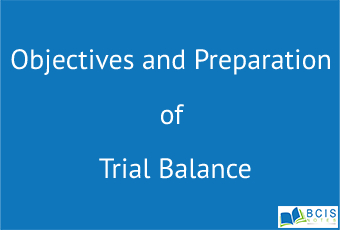
Trial Balance
Objectives and Preparation of trial balance is a bookkeeping worksheet in which the balance of all ledgers is compiled into debit and credit account column totals that are equal. A company prepares a trial balance periodically, usually at the end of every reporting period. The general purpose of producing a trial balance is to ensure the entries in a company’s bookkeeping system are mathematically correct.
How a Trial Balance Works
Objectives and Preparation of trial balance for a company serve to detect any mathematical errors that have occurred in the double-entry accounting system. If the total debits equal the total credits, the trial balance is considered to be balanced, and there should be no mathematical errors in the ledgers. However, this does not mean there are no errors in a company’s accounting system. For example, transactions classified improperly or those simply missing from the system could still be material accounting errors that would not be detected by the trial balance procedure.
Objectives of Trial Balance
One of the main objectives of the trial balance is to ensure that the total of all debits equals the total of all the credits. Preparing the trial balance is the third step of the accounting process. After journalizing and posting all entries in the ledgers, the bookkeepers prepare the trial balance. In the double-entry system of accounting, debit is always equal to the credit. This means every individual account is perfectly matched. It also means that all accounts of the entity must match perfectly. One way to check this accuracy is through the Trial Balance of the company.
- It ensures that the posting from the ledgers is done correctly. If there are any arithmetic errors in the accounting then this will get reflected in the trial balance. And we can determine this when the total of the debit column and the credit column do not match.
- Similarly, it will also detect clerical errors, like a fault in posting, mixing up of figures, etc.
- The trial balance will also help in the preparation of the final accounts. The balances for the financial statements are taken from the trial balance.
- And the trial balance will also serve as a useful summary of all accounting records. It is a summary of all the ledger accounts of a firm. We will only refer to the individual ledger accounts if any details are needed. Otherwise, we rely on the trial balance.
Preparation of Trial Balance
The first step in the preparation of final accounts is the preparation of the trial balance. So it is absolutely essential that we prepare the trial balance perfectly, so our final accounts do not contain any errors. Let us learn more about the methods and procedures of preparation of trial balance. Preparation of trial balance is the third step in the accounting process. First, we record the transactions in the journal. And then we post them in the general ledger. Then we prepare a trial balance to verify that the debit totals equal to the credit totals.
Let us take a look at the steps in the preparation of the trial balance.
- To prepare a trial balance we need the closing balances of all the ledger accounts and the cash book as well as the bank book. So firstly every ledger account must be balanced. Balancing is the difference between the sum of all the debit entries and the sum of all the credit entries.
- Then prepare a three-column worksheet. One column for the account name and the corresponding columns for debit and credit balances.
- Fill out the account name and the balance of such account in the appropriate debit or credit column
- Then we total both the debit column and the credit column. Ideally, in a balanced error-free Trial balance these totals should be the same
- Once you compare the totals and the totals are the same you close the trial balance. If there is a difference we try and find and rectify errors. Here are some cases that cause errors in the trial balance
- A mistake in transferring the balances to the trial balance
- Error in balancing an account
- The wrong amount posted in the ledger
- Made the entry in the wrong column, debit instead of credit or vice versa
- Mistake made in the casting of the journal or subsidiary book
You may also like Normal Account Balances

Leave a Reply